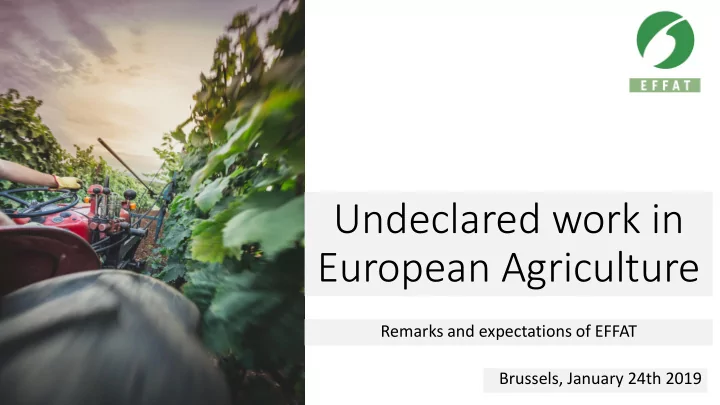

Undeclared work in European Agriculture Remarks and expectations of EFFAT Brussels, January 24th 2019
Agricultural workers in Europe
Dependent work in Agriculture 11 million workers in EU-28 + candidate countries • EUROSTAT assumes about 2 million workers The presentation in the Annual Work Unit does not reflect real employment in the sector • Annual work units (AWU) are statistical measures based on general assumptions and more or less rough estimates. Behind an annual work unit several people can stand Jobs for skilled workers become higher quality • Specialization, digitization and the development of agricultural services have created high-quality jobs in terms of pay levels and working conditions Importance of workers in agriculture is increasing • Overall, the numbers of people working in agriculture are falling, but the shift from family workers to workers is increasing significantly. The workers are of increasing importance Income from agriculture is often the most important contribution to family income • We assume that a larger share of the working population and their family members live solely on income from agriculture than previously assumed
Decent and precarious workers Länderkür zel I ∑ Full time + Arbeitnehmer Einheit Full-time Part-time SO Code Total in Personen Part time 3166 IR 17.200 AWU 13.200 10.100 3.100 460.035 Personen 460.035 303.695 156.340 AL IS 500 AWU 500 393 107 AT 96.500 Personen 45.500 18.000 27.500 IT 952.000 Personen 952.000 75.100 876.900 74.088 BE Personen 3.570 3.090 480 LU 1.200 AWU 1.200 1.000 200 BG 101.000 AWU 75.200 53.300 21.900 LV 20.300 AWU 14.300 14.000 300 144.000 BiH 144.000 116.000 28.000 MT 600 AWU 500 400 100 CY 4.300 AWU 5. 000 3.700 1.300 NL 113.487 AWU 64.600 43.000 21.600 CZ 100.900 AWU 78.000 74.000 4.000 NO 18.000 AWU 10.000 6.900 3.100 665.244 Personen 515.000 200.700 314.300 DE PL 376.300 Personen 367.300 67.300 300.000 DK 44.100 Personen 44.100 38.700 5.400 PT 60.600 AWU 73.400 48.500 24.900 760.200 760.200 693.700 66.500 ES RO 89.800 AWU 166.300 65.500 100.800 EE 13.300 AWU 11.800 11.300 0.500 SE 40.000 AWU 22.000 18.000 104.820 Personen 48.105 7.200 40.905 FI SK 52.300 Personen 52.300 47.312 4.988 FR 1.373.907 Personen 1.373.907 206.420 1.167.487 SI 2.600 AWU 5.200 2.200 3.000 25.100 GR AWU 68.600 17.200 51.400 TR 4.500.000 149.129 2.500.000 HR 13.500 AWU 11.900 10.100 1.800 UK 110.800 AWU 92.500 73.800 18.700 97.400 HU AWU 119.000 85.300 33.700 Summe 10.434.081
Undocumented work in Agriculture 1/3 of agricultural workers are not recorded • The research and case studies in this project suggest that 1/3 of agricultural workers are not covered. High amount of informal work in agriculture • Previous studies by EFFAT assume about 25% of informal work in the agricultural sector. Precarious employment is increasing • According to our surveys, we expect around 70% of precarious employment. Importance of workers in agriculture is increasing • Overall, the numbers of people working in agriculture are falling, but the shift from family workers to workers is increasing significantly. The workers are of increasing importance. Income in agriculture is below comparable sectors • Due to the low level of wages in agriculture, a large proportion of workers are threatened by old-age poverty.
Description of the problems 40% of the Agricultural workers are cross-border-migrants More then 20% of the migrants are coming from third-countries In some regions a lot of migrants have an illegal status Level of integration Lack of access to social security Lack of access to information Lack of support
Expectations from trade unions National Level • Clear responsibility on national level – one single contact person or vocal point Transnational Level • Better cooperation between the responsible institutions • Transparent information duties and competences European Level • Better cooperation between the responsible institutions (Common controls) • New instruments (e.g. Social attachés at the embassies) • Create new paths to combine cooperation with legal instruments • Excess of data • Integration of the Social Partners (e.g. in the ELA) – e.g. annual reports and annual meetings of exchange
Expectations from trade unions Observatory • A European labour observatory for agricultural workers can be helpful, e.g. inside ELA Commun rules on national level • Rules that can be used in every country by every institution VET • transparent systems on comparison and recognition of qualifications in Europe. Approaches to this are e.g. the Agripass and the ESCO classifications • Financing VET for workers also through the second pillar of the CAP • Social partners and national institutions : For the content and structures of initial and continuing vocational training, equal representation committees should be established • More European exchange of young people as part of their education • Initial education requires the development of transnational educational content and a mission statement "Vocational Education for Sustainable Development"
Thank you for your attention: EFFAT Arnd Spahn Agricultural secretary 130A Avenue Louise BE 1050 Brussels Tel: +32.476.71.91.80 a.spahn@effat.org www.effat.org
Recommend
More recommend